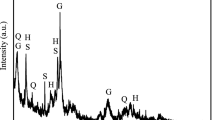Abstract
Purpose
This paper presents a cradle-to-grave comparative life cycle assessment (LCA) of new gas atomised (GA) sponge nickel catalysts and evaluates their performance against the current cast and crush standard currently used in the industrial hydrogenation of butyraldehyde to butanol.
Methods
A comparative LCA has been made, accounting for the energy used and emissions throughout the entire life cycle of sponge nickel catalysts—ranging from the upstream production of materials (mainly aluminium and nickel), to the manufacturing, to the operation and finally to the recycling and disposal. The LCA was performed following ISO14040 principles where possible, and subsequently implemented in the software package GaBi 4.3. The CML2001 impact assessment methodology was used, with primary focus on comparing catalysts for equivalent greenhouse gasses generated over their lifetime and their relative global warming potential and secondary focus on acidification potential. This is justified as the lifetime is dominated by energy use in the operational phase, and acidification is dominated by the production of nickel for which existing ISO14040 collected data has been used. A sensitivity analysis was used to provide a number of scenarios and overall environmental performances of the various sponge nickels considered when compared to the existing industrial standard.
Results and discussion
It was found that the energy and emissions during the operation phase associated with a given catalyst significantly outweigh the primary production, manufacturing and recycling. Primary production of the nickel (and to a lesser extent molybdenum when used as a dopant) also has a significant environmental impact in terms of acidification potential, but this is offset by operational energy savings over the catalysts’ estimated lifetime and end of life recyclability. Finally, the impact of activity improvement and lifetime duration of sponge nickel catalysts was determined as both total life cycle energy for operational use and as a total life cycle global warming potential.
Conclusions
From this assessment, the newly developed, higher activity spongy nickel catalysts produced by gas atomisation could have a significantly lower environmental impact than the current industry standard cast and crush method. Given the potential environmental benefits of such catalysts, applications in other processes that require a catalyst should also be investigated.









Similar content being viewed by others
References
Afeefy HY, Liebman JF, Stein SE (2000) Neutral thermochemical data, NIST Chemistry WebBook, NIST Standard Reference Database
Agnic R, Resnik M (2006) Effects of Raney-type nickel catalyst production scale pretreatment. Chem Biochem Eng Q 20:119–123
Agrawal R, Auvil SR, Choe JS (1989) Process for the production of Argon, US Patent 4817392
Barnard NC, Brown SGR, Devred F, Bakker JW, Nieuwenhuys BE, Adkins NJ (2011) A quantitative investigation of the structure of Raney-Ni catalyst material using both computer simulation and experimental measurements. J Cat 281:300–308
BioButanol (2011) Biobased Butanol Information. http://www.biobutanol.com/Research-Study.html. Accessed 12 Dec 2011
Boustead I (2005) Eco-profiles of the European Plastics Industry: sodium hydroxide. http://lca.plasticseurope.org/pc7.htm. Accessed 31 Jul 2012
Buckley E, Cox JD (1967) Chemical equilibria Part 2—dehydrogenation of propanol and butanol. Trans Faraday Soc 63:895–901
Capello C, Wernet G, Sutter J, Hellweg S, Hungerbühler (2009) A comprehensive environmental assessment of petrochemical solvent production. Int J Life Cycle Assess 14:467–479
Chen Q (2006) Toward cleaner production of hydrogen peroxide in China. J Cleaner Prod 14:708–712
Classen M, Althaus H, Blaser S, Doka G, Jungbluth N, Tuchschmid M (2009) Life cycle inventories of metals. Final report ecoinvent data v.2.1 no.10. Swiss Centre for Life Cycle Inventories, Dübendorf
Cropley J, Burgess L, Loke R (1984) The optimal design of a reactor for the hydrogenation of butyraldehyde to butanol. In: Dudukovi MP MP, Mills PL (eds) Chemical and catalytic reactor modeling, Vol 237. ACS, Washington, pp 255–271
Devred F, Gieske AH, Adkins N, Dahlborg U, Bao CM, Calvo-Dahlborg M, Bakker JW, Nieuwenhuys BE (2009) Influence of phase composition and particle size of atomised Ni–Al alloy samples on the catalytic performance of Raney-type nickel catalysts. Appl Catal A: General 356:154–161
Devred F, Reinhart G, Iles GN, van der Klugt B, Adkins NJ, Bakker JW, Nieuwenhuys BE (2011) Synchrotron X-ray microtomography of Raney-type nickel catalysts prepared by gas atomisation: Effect of microstructure on catalytic performance. Catal Today 163:13–19
Dreyer LC, Niemann AL, Hauschild MZ (2003) Comparison of three different LCIA methods: EDIP97, CML2001 and Eco-indicator 99. Int J Life Cycle Assess 8:191–200
Dufour J, Serrano D, Galvez J, Moreno J, Garcia C (2009) Life cycle assessment of processes for hydrogen production. Environmental feasibility and reduction of greenhouse gases emissions. Int J Hydrogen Energy 34:1370–1376
Dunkley JJ, Aderhold D (2007) Centrifugal atomization of metal powders. In: International Conference on Powder Metallurgy & Particulate Materials, Denver, pp 26–31
Ecobalance (2000) Life cycle assessment of nickel products. Nickel Institute. http://www.nickelinstitute.org/en/Sustainability/LifeCycleManagement/LCI_Project2000/NickelproductsLCIreport.aspx. Accessed 31 Jul 2012
Ekmann A, Börjesson P (2011) Life cycle assessment of mineral oil-based and vegetable oil-based hydraulic fluids including comparison of biocatalytic and conventional production methods. Int J Life Cycle Assess 16:297–305
Flower DJM, Sanjayan JG (2007) Green house gas emissions due to concrete manufacture. Int J Life Cycle Assess 12:282–288
Forzatti P, Lietti L (1999) Catalyst deactivation. Catal Today 52:161–181
Geisler G, Hofstetter TB, Hungerbühler K (2004) Production of fine and speciality chemicals: procedure for the estimation of LCIs. Int J Life Cycle Assess 9:101–113
Gielen D (2006) Proposal for Energy and CO2 Emission indicators in the petrochemical sector. In: IEA Workshop: feedstock substitutes, energy efficient technology and CO2 reduction for petrochemical products in collaboration with CEFIC IEA, Paris, 12–13 December
Hassan A, Richter S (2002) Closed loop management of spent catalysts in the chemical industry. Chem Eng Tech 25:1141–1148
Häussinger P, Glatthaar R, Rhode W, Kick H, Benkmann C, Weber J et al (2000) Noble gases. Wiley-VCH, Weinheim
PE International GmbH (2008) European Commission Joint Research Centre: LCA Tools, Services and Data website. http://lca.jrc.ec.europa.eu/lcainfohub/tool2.vm?tid=252. Accessed July 2010
Jarvis DJ, Voss D (2005) IMPRESS Integrated Project—an overview paper. Mat Sci Eng: A 413–414:583–591
Kellogg H (1974) Energy efficiency in the age of scarcity. J Metals 26:25–29
Kellogg H (1977) Sizing up the energy requirements for producing primary materials. Eng Min J 178:61–65
Kellogg H (1982) The state of non-ferrous extractive metallurgy. J Metals 34:35–42
Kim S, Jiménez-González C, Dale BE (2009) Enzymes for pharmaceutical applications—a cradle-to-gate life cycle assessment. Int J Life Cycle Assess 14:392–400
Koch M, Harnisch J (2002) CO2 emissions related to the electricity consumption in the European primary aluminium production a comparison of electricity supply approaches. Int J Life Cycle Assess 7:283–289
Landfield Greig A (2008) Life cycle inventory of metallurgical molybdenum products. Four Elements Consulting Inc for the International Molybdenum Association, Brussels
Larsen PB, Tyle H (2008) Nickel and nickel compounds: report for the Danish Environmental Protection Agency
Laurent A, Olsen SI, Hauschild MZ (2012) Limitations of carbon footprint as indicator of environmental sustainability. Environ Sci Technol 46:4100–4108
Lui Y, Xue H-F (2012) OXO market supply and demand forecast & investment economic analysis. Financ Res 1:4–10
Marafi M, Stanislaus A (2008) Spent catalyst waste management: a review. Part I: developments in hydroprocessing catalyst waste reduction and use. Resour Conserv Recy 52:859–873
Mattila T, Tuomas Helin T, Antikainen R (2012) Land use indicators in life cycle assessment: a case study on beer production. Int J Life Cycle Assess 17:277–286
McCann TJ (2000) Alberta Propylene Upgrading Prospects
Mclaughlin MJ (2004) Heavy metals—the full picture, national, international and local. In: Conference of the Australian Federation Fertilizer Industry, Couran Cove, FIFA, Canberra
Motz J (2000) Method and device for utilizing heat in the production of 1,2-dichloroethane. US Patent 6693224
Nielsen PH, Oxenbøll KM, Wenzel H (2007) Cradle-to-gate environmental assessment of enzyme products produced industrially in Denmark by Novozymes A/S. Int J Life Cycle Assess 12:432–438
Norgate T (2004c) Metal recycling: an assessment using life cycle energy consumption as a sustainability indicator. CSRIO Minerals Report DMR-2616
Norgate T, Rankin W (2000) Life cycle assessment of copper and nickel production. In: International Conference on Minerals Processing and Extractive Metallurgy, Melbourne, pp 133–138
Norgate T, Rajakumar V, Trang S (2004a) Titanium and other light metals-technology pathways to sustainable development. Green Processing, pp 1–15
Norgate T, Jahanshahi S, Rankin W (2004b) Alternative routes to stainless steel-a life cycle approach. In: Proceedings: Tenth International Ferroalloys Congress, Cape Town, p 4
Norgate T, Jahanshahi S, Rankin W (2007) Assessing the environmental impact of metal production processes. J Cleaner Prod 15:838–848
Pourghahramani P (2006) Effects of grinding variables on structural changes and energy conversion during mechanical activation using line profile analysis. Dissertation, Luleå University of Technology
Raney M (1925) Method of preparing catalytic material. US Patent 1563587
Raney M (1927) Method of producing finely-divided nickel. US Patent 1628190
Sailing P, Kicherer A, Dittrich-Kramer B, Wittlinger R, Zombik W, Schmidt I, et al (2002) Eco-efficiency analysis by BASF: the method. Int J Life Cycle Assess 7(4):203–218
Saur K (2003) Life cycle assessment of aluminium: inventory data for the worldwide primary aluminium industry. International Aluminium Institute, London
Somorjai GA, Li Y (2010) Introduction to surface catalysis. Wiley, Hoboken, pp 559–626
Tufvesson LM, Börjesson P (2008) Wax production from renewable feedstock using biocatalysts instead of fossil feedstock and conventional methods. Int J Life Cycle Assess 13:328–338
Ueda A, Sadaie K (1999) Method for producing butyraldehydes. US Patent 5865957
Valero A, Botero E (2002) Exergetic evaluation of natural mineral capital (2) Application of the methodology to current world reserves, in: Proceedings Of the 15th International Conference On Efficiency, Costs, Optimization, Simulation and Environmental Impact Of Energy Systems (ECOS), Berlin, Germany July 3–5, p 151–157
Wernet G, Hellweg S, Hungerbühler K (2012) A tiered approach to estimate inventory data and impacts of chemical products and mixtures. Int J Life Cycle Assess 17(6):720–728
Yule AJ, Dunkley JJ (1994) Atomization of melts for powder production and spray deposition. Oxford University Press, Oxford
Acknowledgements
This work was funded under EC FP6 project IMPRESS (NMP-CT-2004-500635). A special thanks is also made to Dr Nick Adkins (CERAM-UK), Dr. Francois Devred, Prof. Ben Nieuwenhuys (Leiden University), Dr Sean Axon, Daniel Cairns (Johnson-Matthey), David Eaves and Chloe Johns (Swansea University) for all their inputs.
Author information
Authors and Affiliations
Corresponding author
Additional information
Responsible editor: Guido Sonnemann
Rights and permissions
About this article
Cite this article
Lavery, N.P., Jarvis, D.J., Brown, S.G.R. et al. Life cycle assessment of sponge nickel produced by gas atomisation for use in industrial hydrogenation catalysis applications. Int J Life Cycle Assess 18, 362–376 (2013). https://doi.org/10.1007/s11367-012-0478-8
Received:
Accepted:
Published:
Issue Date:
DOI: https://doi.org/10.1007/s11367-012-0478-8




